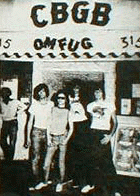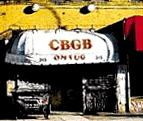INTRODUCTION: PUNK ROCK
Thepopular misperception is that Punk Rock began during the late 70's in London, England. However, Punk was in fact an American creation that grew out from the tangled roots of early Rock and Roll. Its now been nearly 25 years (33 if you start with the Velvet Underground) since Punk first emerged from New York's Greenwich village and surfaced at the small bar in the Bowery called CBGB's.
It was here in 1975, among the Hell's Angels, wino's, junkies, and prostitutes that bands such as the Talking Heads, Richard Hell and the Voidoids, the Patti Smith Group, Deborah Harry (Blondie), and the Ramones all launched their careers and reinvented the sound, look, and attitude of rock music for generations to come.
 One
of the driving forces behind punk rock, as with most forms of rock music,
was rebellion. The general consensus was that the rock and roll industry
had become too safe, mainstream, corporate, and therefore no fun.
Many of these early punk groups took it upon themselves to express their
displeasure with the direction music had taken in the mid-70's and tried
make rock dangerous again. Although these attitudes were shared by
early punk rock groups, a similar sound was not. Each of these early
groups developed their own unique sound that separated them from the
others.
One
of the driving forces behind punk rock, as with most forms of rock music,
was rebellion. The general consensus was that the rock and roll industry
had become too safe, mainstream, corporate, and therefore no fun.
Many of these early punk groups took it upon themselves to express their
displeasure with the direction music had taken in the mid-70's and tried
make rock dangerous again. Although these attitudes were shared by
early punk rock groups, a similar sound was not. Each of these early
groups developed their own unique sound that separated them from the
others.
The word 'dirty' comes up frequently in a discussion about punk rock. Often this term is a reference to the discordant sounds produced by guitars amplified to the point of feedback, or white noise. "Dirty" could also refer to the lyrical content that is often considered vulgar. But it also has as much to do with the appearance of the practitioners. In this respect it is important to consider the visual aesthetic of punk rock musicians because of the impact these styles had on underground youth culture of the time, and mainstream culture that followed in the 80's and 90's. Additionally, punk rock fashion, an oxymoron to some, signified the movement as a more individualistic, and a reaction to mainstream culture.
In New York, punk rock might have signified a rebirth of rock and roll, but in London an entire culture was conceived. Like a blowtorch, punk roared throughout the towns of England leaving the charred remains of popular culture in its path. Although stylistically punk was a world away from 1960's protest music, both shared the same basic goal to inspire change through musical expression.
This was especially true in London where the social climate was one of poverty and frustration. Unemployment soared to record levels while the economy plummeted into the deepest depression since World War II fueling the uneasiness of the younger generation. While 1970's America offered boundless opportunities for the baby boomers, British youth were faced with few choices for their future. In addition to economic despair, increasing division between the upper and lower class people outraged many sparking violence throughout the country.
These factors contributed to the deeply political overtones that punk embodied once it made its way across the pond. Britain's youth were desperately bored and seeing no future on their horizon sought alternative means of survival. Punk rock offered an escape from the hopeless conditions of late 1970's London, while simultaneously empowering the thousands of young people who had been marginalized by a culture in turmoil.

In addition to the raw musical aggression, punk embraced an almost primitive fashion aesthetic which featured spiky hair, multi-colored mohawks, and ripped t-shirts cleverly held together with safety pins that made their way into the noses, ears and tongues of those eager to push the boundaries of acceptable attire. For many, punk fashion took the gender bending kinkiness of glam rock and injected it with a lethal dose of black leather and gothic barbarism in the form of heavy make-up. The resulting styles were caustic and offensive, however they were also refreshingly inventive, fascinating, and sublimely rebellious.
The abrasive character of punk was as unsettling to hear, as it was to observe for many, however as it has always been viewed with skepticism by mainstream audiences, it has endured to permanently alter the look, sound and attitude of rock music to this day.
Page author: A.E.

